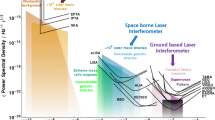Summary
The observation of Fresnel diffraction patterns at 2nd and 3rd contact and efforts to correlate the time elements of a total solar eclipse at low elevation are discussed. The measurements were intended to determine atmospheric refraction at three optical wavelengths. A laboratory model of the system sun-moon-earth was employed for testing the recording instruments at the fast response times that are necessary for such observations.
Zusammenfassung
Diskutiert werden die Vorbereitungen zur Beobachtung von Fresnelschen Beugungsstreifen im Mondschatten, wenn 2. und 3. Kontakt einer Sonnenfisternis in die Sonnenaufgangszone fallen (streifender Lichteinfalt). Bei Kenntnis des Mondrandes kann man die Auswertung der Beugungsfiguren mit den Konjunktionszeiten korrelieren. Vergleiche mit den errechneten Ephemeriden ermöglichen eine Bestimmung der atmosphärischen Refraktion. Ein Modell diente zur Prüfung der Beobachtungsapparaturen.
Similar content being viewed by others
References
A. S. Eddington,Note: On the Determination of the Apparent Diameter of Fixed Star, M.N.R.A.S.69 (1908), 178.
T. D. v. Flandern,Extreme Grazing Occultations, Sky and Telescope, July 1964.
K. D. Rokas,Die Bestimmung der Sterndurchmesser ... mit Fresnelscher Beugungsfigur, Acta Physica Austrica 26/152 und 289/1967.
A. Bemporad,Die Atmosphärische Strahlenbrechung in Hdb. d. phys. Optik. Vol. 1 (Leipzig, 1926)
K. Ya. Kondratyev,Radiation in the Atmosphere (Academic Press, New York, 1969), pp. 161ff.
Lyman J. Briggs,Observed and Computed Radiation... During a Solar Eclipse, Trans. Am. Geophys. Union38 (1957), 17. Also compare: Applied Optics7 (1968), 705.
R. Gerharz,Photometric Brightness Asymmetry During a Lunar Eclipse, Arch. Met. Geoph. Biokl. Ser. [A]18 (1969), 221.
H. Kristensen,The precise Timing of the Solar Eclipse..., Ark. f. Astronomi2 (1959), 315.
F. J. Heyden et al.,Spectra and Intensity of Light... near Totality, Ap. J.118 (1953), 412.
K. Nottarp andH. U. Sandig,Die Bestimmung des Zeitpunktes der Finsternismitte, Dtsch. Geod. Komm., Mitt. Nr.16 (1957), 29.
Compare the diagram ofBurgess andHults (Sky and Telescope, p. 95, August 1969) where this technique was wrongly applied to shadow bands.
S. D. Gossner,The Total Eclipse of 2 October 1959, US-Naval Obs. Circ. Nr. 78.
Author information
Authors and Affiliations
Rights and permissions
About this article
Cite this article
Gerharz, R. Observational effort to record Fresnel patterns during a total solar eclipse. PAGEOPH 96, 163–166 (1972). https://doi.org/10.1007/BF00875638
Received:
Issue Date:
DOI: https://doi.org/10.1007/BF00875638




